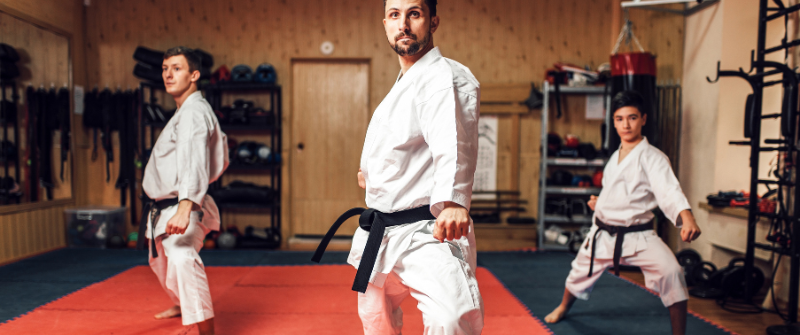
- by NEXO Team
- August 4, 2025
Opening a martial arts studio means stepping into a world that’s equal parts discipline, energy, and unpredictability. Injuries, property damage, legal disputes, and financial setbacks are all common risks for new martial arts gyms, and without a plan, they often hit hard. Along with protecting your space and gear, strong risk management in martial arts also safeguards your students, staff, and the business you’re working so hard to build.
Ahead are practical steps on how to build a risk management plan for a martial arts studio, covering safety practices, legal protection, and the right martial arts insurance to back you up.
Understanding the Risks in a Martial Arts Studio
Every martial arts startup faces real-world risks that could impact safety, finances, and daily operations. Before building out the space or signing up your first student, it’s a good idea to take a closer look at the most common risks for new martial arts gyms and how to manage them.
- Physical injuries: Students can get hurt during sparring or drills. Instructors and visitors face similar risks, which makes martial arts insurance an important layer of protection.
- Liability issues: Slips, falls, or claims of negligence may lead to costly legal trouble.
- Property risks: Fire, theft, or equipment damage can disrupt your schedule and result in unplanned repairs or losses.
- Staff risks: Injuries, internal disputes, or misconduct can affect morale and disrupt operations.
- Reputational risks: Negative reviews or social media backlash can hurt trust and slow down growth.
Key Components of a Risk Management Plan
Having a written plan sets the foundation for effective risk management in martial arts. It gives structure to your decision-making and keeps your martial arts business prepared when something unexpected happens. Relying on informal practices often leads to gaps that leave you exposed to common risks for new martial arts gyms. A clear, documented plan, on the other hand, shows that you’ve taken steps to meet insurance requirements for martial arts business startups and protect every single person who walks through your doors.
Regular risk assessments help you spot potential issues early and adjust your approach as your martial arts startup grows. Assigning roles during a crisis, like who contacts emergency services or handles communication with parents, reduces confusion and keeps things running more smoothly. Your plan should also outline basic safety protocols, like how to report injuries or maintain equipment. These kinds of procedures are part of the best practices for martial arts business safety planning and help reinforce your studio’s legal protection.
Also Read: What Are the Startup Costs Like for a New Martial Arts Gym?
Insurance: Your Safety Net
Insurance is a core part of risk management for martial arts studios. It helps protect a business against some of the most common risks it’ll face as it grows, including injuries, lawsuits, and property damage. The right martial arts insurance may also help you meet insurance requirements for martial arts business startups and provide added support when things don’t go as planned. Most studios will need a combination of these coverage types:
- General liability insurance: Covers third-party injuries and property damage, such as a student slipping in the lobby or a parent’s phone getting broken during class.
- Professional liability insurance: Applies to claims related to instruction, such as if someone alleges an injury was caused by improper training.
- Workers’ compensation: Covers employee injuries and helps your martial arts business stay compliant with labor laws.
- Property insurance: Covers your physical space and equipment in case of fire, theft, or other damage.
Coverage needs will vary depending on the size of the martial arts startup, how classes are structured, and what local laws require. A broker who understands martial arts studio liability and legal protection will help you make sense of all your options, recommend limits that reflect your actual risk, and spot any gaps that might leave you exposed. Working with someone who is familiar with best practices for martial arts business safety planning also saves you time and stress.
Also Read: Liability Insurance for Martial Arts
Safety Protocols and Prevention
Strong safety protocols are a necessary part of risk management in martial arts because they help prevent accidents before they happen. Clean mats, secure equipment, and clutter-free walkways reduce the chances of slips and falls, which are some of the most common risks for new martial arts gyms. These steps also show that your martial arts startup is meeting basic standards tied to martial arts studio liability and legal protection.
Additionally, training your staff well creates a safer experience for everyone on the mat. Instructors should be certified in CPR and first aid, but they also need to know how to teach in a way that reduces risk while supporting skill development. Setting expectations with students and parents through waivers and informed consent helps create clarity and shows that your martial arts business takes safety seriously. Class policies should also be consistent. Grouping students by age and experience, limiting contact during sparring, and keeping every session supervised are all small steps that, together, create a safer environment.
Also Read: Common Insurance Claims in Martial Arts Studios and How to Prevent Them
Legal and Compliance Considerations
Legal and compliance issues are another important part of risk management in martial arts, especially for new studio owners. Waivers can help limit legal exposure, but they don’t remove it entirely. To strengthen martial arts studio liability and legal protection, you’ll also need to follow local business regulations, meet health and safety codes, and keep proper documentation on file.
Hiring qualified instructors is another piece of the puzzle. Make sure their certifications are current and well-documented as part of your safety planning. Protecting your intellectual property matters as well, especially if your martial arts business has a unique curriculum, logo, or brand identity. Taking care of these details early will help you avoid larger problems down the road.
Planning for the Unexpected
Unexpected challenges are part of running any martial arts business, which is why preparation matters just as much as day-to-day operations. An emergency response plan gives you a clear process to follow during accidents, severe weather, or other urgent situations. Everyone on staff should know their role and feel confident taking action when needed.
Financial planning is important, too. Building in a cushion for slow seasons or surprise repairs will help your martial arts startup stay stable when income shifts. Communication is another aspect of risk management that needs to be part of your planning. If classes are canceled or something urgent comes up, you’ll need a reliable way to reach parents, students, and staff. Putting these systems in place early will allow you to stay grounded and responsive, even when things don’t go as expected.
Conclusion
A well-built risk management plan gives your martial arts business structure, clarity, and long-term stability. It helps you protect your students, your staff, and the studio you’ve worked hard to open. Taking steps to address legal risks, meet insurance requirements, and create safe daily operations shows that your martial arts startup is built to last.
If you’re ready to put your plan into action, NEXO will help you find the right coverage and handle the details with confidence. Contact us today to learn more!
Categories
Fill out a short form to contact us with your questions or to receive a customized quote.
Recent Posts
-
 NEXO’s Affinity Program: How Fitness Suppliers and Associations Can Partner for Profit and Protection
December 5, 2025
NEXO’s Affinity Program: How Fitness Suppliers and Associations Can Partner for Profit and Protection
December 5, 2025 -
%20(1).png) How to Insure an MMA Gym Without Paying for Coverage You Don’t Need
December 5, 2025
How to Insure an MMA Gym Without Paying for Coverage You Don’t Need
December 5, 2025 -
 Mastering Liability for Jiu-Jitsu Tournaments and Martial Arts Events
December 5, 2025
Mastering Liability for Jiu-Jitsu Tournaments and Martial Arts Events
December 5, 2025 -
 From Zen to Zoning: What Every Yoga and Pilates Studio Owner Should Know Before Signing a Lease
December 5, 2025
From Zen to Zoning: What Every Yoga and Pilates Studio Owner Should Know Before Signing a Lease
December 5, 2025 -
%20(1).png) Why Your Referral & Loyalty Program Can Impact Your Insurance Rates
December 5, 2025
Why Your Referral & Loyalty Program Can Impact Your Insurance Rates
December 5, 2025
